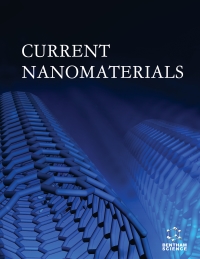- Home
- A-Z Publications
- Current Nanomaterials
- Previous Issues
- Volume 8, Issue 4, 2023
Current Nanomaterials - Volume 8, Issue 4, 2023
Volume 8, Issue 4, 2023
-
-
A Review on Nanofluids: Synthesis, Stability, and Uses in the Manufacturing Industry
More LessAuthors: Jotiram G. Gujar, Sanjay S. Patil and Shriram S. SonawaneNanofluids are a new class of nanomaterials suspended in a base liquid. Nanofluids have shown extremely distinctive properties that give tremendous opportunities for a wide range of applications. Nanofluids are a novel group of heat transfer fluids that have attracted the attention of researchers from various fields due to their intensive thermal properties. This systematic review highlights the synthesis, stability, physic Read More
-
-
-
Nanomaterials: Potential Broad Spectrum Antimicrobial Agents
More LessNanotechnology is a promising science with new aspects to fight and prevent various diseases using nanomaterials. The capability to expose the structure and functions of biosystems at the nanoscale level supports research leading to development in biology, biotechnology, medicine and healthcare. This is predominantly advantageous in treating microbial infections as an alternative to antibiotics. However, widespread pro Read More
-
-
-
Carbon Nanotube – Synthesis, Purification and Biomedical Applications
More LessAuthors: Sudhanshu Mishra, Sonali Kumari, Ayush C. Mishra, Ratnesh Chaubey and Smriti OjhaCarbon Nanotubes (CNTs) are a relatively new class of technical materials with a variety of unique and beneficial features. CNT is a revolutionary carrier technology for both tiny and big medicinal compounds. These formulations can be surface engineered and functionalized with predefined functional groups to control their physical and biological characteristics. CNTs have proven potential for cancer therapy along with other Read More
-
-
-
ZnO Nanostructure Based Gas Sensors: Critical Review Based on their Synthesis and Morphology Towards Various Oxidizing and Reducing Gases
More LessAuthors: Tarannum Shaikh and Shilpa JainNanotechnology has enabled sensors to detect and sense a very small amount of chemical vapors. Sensors play a major role in our daily life. The use of sensors has made human life easy. One such type of sensor is the Gas sensor made up of Semiconducting metal oxides. These sensors have their own unique features which help in the easy monitoring of toxic gases. Out of all the metal oxide present, the gas sensors made up Read More
-
-
-
Nanotechnology in Smart Contact Lenses: Highlights on Sensor Technologies and Future Prospects
More LessThe eye is a complex organ in the body containing a repertoire of metabolite indicators such as glucose, peptides, specialized ions, and many critical biological data such as Intraocular Pressure (IOP), corneal temperature, and pH. Contact lens research and patient care have progressed substantially throughout the last three decades; hence smart contact lenses were developed with significant advancements in material Read More
-
-
-
Efficient Fluoride Removal from Aqueous Solution Using Graphene/Ce Composite Supported on Activated Carbon
More LessAuthors: Ruchita V. Patel and Chandra P. BhasinBackground: More than 260 million people worldwide are affected by excess fluoride (F- > 1.5 mg/L) in their drinking water. Fluorosis of the teeth and skeleton, among other health issues, is caused by it. Objective: The aim of this study is to evaluate the fluoride removal from contaminated water using graphene-based new adsorbent material. Methods: Graphene (G) was prepared by a facile liquid-phase exfoliation method. Read More
-
-
-
Structure, Composition and Morphology of Self-Assembled 2D Nanostructures Based on SnO2 Nanoparticles Observed in Unannealed Mn Doped Hydrated Form of Tin Oxide (II) or (IV) Synthesized by Co-precipitation Method
More LessBackground: 2D nanostructures are greatly interested in different technological applications, particularly optoelectronics. Tin oxide 2D nanostructures have shown great transparency and ideal charge carrier transport properties. Objective: The current study aims to evaluate the main characteristics of 2D-nanostructures observed during the synthesis of hydrated forms of tin oxide (II) or (IV) doped with Mn. Metho Read More
-
-
-
Adsorption of Chromium (VI) from Aqueous Solution Using Nano TiO2 Doped Strong Base Anion Exchange Resin
More LessBackground: The evolution of environmentally-safe methods for treating hazardous chemicals in wastewater, particularly urban and industrial wastewater, has increased interest over recent years. The chromium-containing wastewater is produced by industries from steel, metallurgical, electroplating, chemical, refractory, leather tanning, dye manufacturing, mining, cementing, textiles, etc. Consequently, advanced tech Read More
-
-
-
Fabrication of Zein/PVA Fibre Blends: Optimizing Concentration and Applied Voltage
More LessAuthors: Nompumelelo S.M. Kubheka, Makwena J. Moloto and Nolutho MkhumbeniBackground: The fabrication of polymer fibre blends has gained much attention for the development of innovative nanomaterials. Polymer fibre blends are nanomaterials with different functionalities and properties such as a sizeable surface-to-area ratio, high porosity, flexibility, and stability. The focus of this study was to produce zein/PVA fibre blends using the electrospinning technique and varying parameters such as conce Read More
-
Most Read This Month
Article
content/journals/cnm
Journal
10
5
false
en


